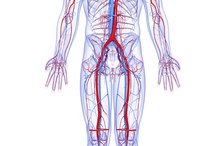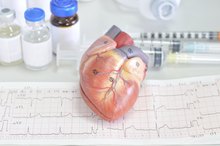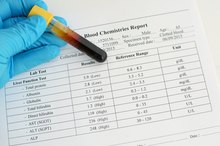What Are the Three Major Parts of the Cardiovascular System?
The human body has 11 major organ systems, each with specific functions and energy needs. The cardiovascular system, or CVS, serves all of them, delivering vital nutrients, picking up and distributing metabolic products and carrying away waste for elimination. The CVS is composed of 3 major components: the heart, the arteries and the veins.
The Heart
The human heart consists of two pumps, joined side by side. Each side has 2 chambers, an atrium and a ventricle. The atrium receives blood and transfers it to the ventricle for expulsion from the heart. The atrium is separated from the ventricle by a 1-way valve that closes when the ventricle pumps and prevents blood from going backward into the atrium. The ventricle has another one-way valve that permits flow into the outgoing blood vessel and prevents backward flow. The left heart receives oxygen-enriched blood from the lungs and sends it to the rest of the body. The right heart receives the blood returned from the body -- laden with carbon dioxide -- and sends it to the lungs for exchange with oxygen.
- The human heart consists of two pumps, joined side by side.
- The left heart receives oxygen-enriched blood from the lungs and sends it to the rest of the body.
The Arteries
What Are the Largest Blood Vessels in the Body?
Learn More
The arteries carry blood from the heart to the entire body. The pulmonary arteries carry blood to the lungs, and the systemic arteries supply the other organ systems. Arteries are muscular vessels, and their walls contract and relax in response to hormones and medications. The resulting changes in diameter are major determinants of how much blood flows to one organ or another and how high your blood pressure is from moment to moment.
- The arteries carry blood from the heart to the entire body.
The Veins
Veins return blood to the heart. Pulmonary veins carry blood from the lungs to the heart, and systemic veins return blood from all other organ systems except for the digestive tract. Blood from the digestive tract is transported to the liver by the portal veins before returning to the heart. Veins have less muscle in their walls than their corresponding arteries, but their contractions and relaxations still play a role in the regulation of blood flow into the heart.
- Veins return blood to the heart.
- Pulmonary veins carry blood from the lungs to the heart, and systemic veins return blood from all other organ systems except for the digestive tract.
The Capillaries
What Causes a Pulse in an Artery?
Learn More
The major components of the CVS -- the heart, arteries and veins -- are coordinated in their rhythms and flows by the nervous system, hormones and other natural substances to deliver life-sustaining blood to the capillaries of each organ in the body. Capillaries are blood vessels so small that microscopic red blood cells pass through them in single file. These minute vessels connect the arteries to the veins. The exchange of oxygen and nutrients for carbon dioxide and other metabolic byproducts occurs at the capillaries.
- The major components of the CVS -- the heart, arteries and veins -- are coordinated in their rhythms and flows by the nervous system, hormones and other natural substances to deliver life-sustaining blood to the capillaries of each organ in the body.
Related Articles
References
- Medical Education for Undergraduate MD Students: Overview of Heart Anatomy
- The American Journal of Physiology: Heart and Circulatory Physiology -- The History of the Capillary Wall -- Doctors, Discoveries, and Debates
- NIH National Heart, Lung, and Blood Institute. How the heart works.
- Lang RM, Badano LP, Mor-Avi V, et al. Recommendations for Cardiac Chamber Quantification by Echocardiography in Adults: An Update From the American Society of Echocardiography and the European Association of Cardiovascular Imaging. J Am Soc Echocardiogr 2015; 28:1.
- Otto CM. Textbook of Clinical Echocardiography, 4th edition, Saunders Elsevier, 2009.
Writer Bio
C. Richard Patterson is a retired surgeon and chief medical officer with special interest and experience in gastrointestinal, breast, cancer and trauma surgery. He is the author or co-author of 17 scientific publications, including textbook chapters.






